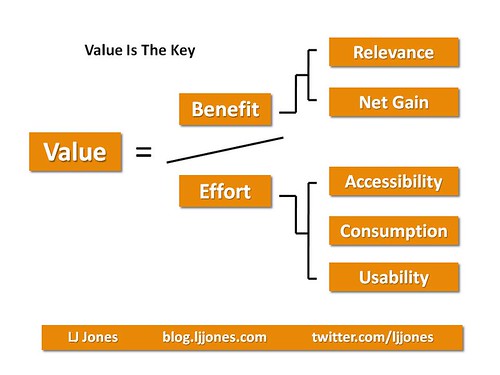Value is when the benefit received is greater than the effort that is put in.
As a math equation
Value = Benefit / Effort
Something is valuable as long as the benefit is greater than the effort. You may even get away with the benefit being equal to the effort. But the moment the effort is greater than the benefit, there is no value. No one wants a 1 for the price of 2 deal.
Breaking it down into benefit and effort gives us two manageable parts that we can affect to reach the desired result of increased value. To increase value we can focus on increasing benefit, focus on reducing effort or a combination of the two.
BenefitTo better understand how to affect benefit, we break it down into relevance and net gain.
Relevance is a measure of how important or interesting the audience finds a given message or interaction. It is important to note that relevance does not measure whether an audience finds a particular message good or bad. A counterpoint or difference of opinion is still relevant as long it is centered on a common interest that is shared by the participants.
Net gain is a measure of the overall increase that a person receives because of the interaction. This may be an increase in knowledge, entertainment, ego, financial or social status.
EffortEffort, as it relates to social media, can be further broken down into the three basic components of accessibility, consumption and usability.
Accessibility is how easy it is to find, see or engage in the interaction. Remove barriers, make it more visible and give people the right information where and when they need it to be able to interact. This includes things like providing a bookmarking button at the end of a post, visible links to your social media profiles in the navigation of your blog or simplifying the form that captures a person’s contact info before they download a white paper.
Consumption means that the message occurs in a form that the audience is familiar with and can easily digest and participate with. For example, a blog is consumable when it’s written in language that the audience understands and the length isn’t longer than the audience’s attention span.
Usability determines how easy it is for a person to apply what they have gained after the initial interaction. It ensures that the message or interaction is easy to use or execute. Things that decrease usability are legal issues, copyrights, downloading third party software, an association that may embarrass a person in front of their peers, or any other hoop someone might have to jump through in order to further use the message. Youtube does a great job with this by providing embeddable code in a neat little window that makes it easy for non programmers to share and post a video.
As I said before, value is the key to successful social media participation. Make a commitment to provide value to those you interact with through every conversation, marketing campaign, blog post, tweet and interaction and you will be successful.
I am currently putting together a Value Checklist which will outline specific action items that should be accomplished in order to increase value in your social media interactions and messages. If you would like to receive a copy of the checklist, please email at ljjones6 at gmail dot com.









